Fordson Model N
Posted by Chris Graham on 1st August 2020
Chris Graham gets under the skin of the Fordson Model N, to discover more about buying and owning one of these iconic little vintage tractors.
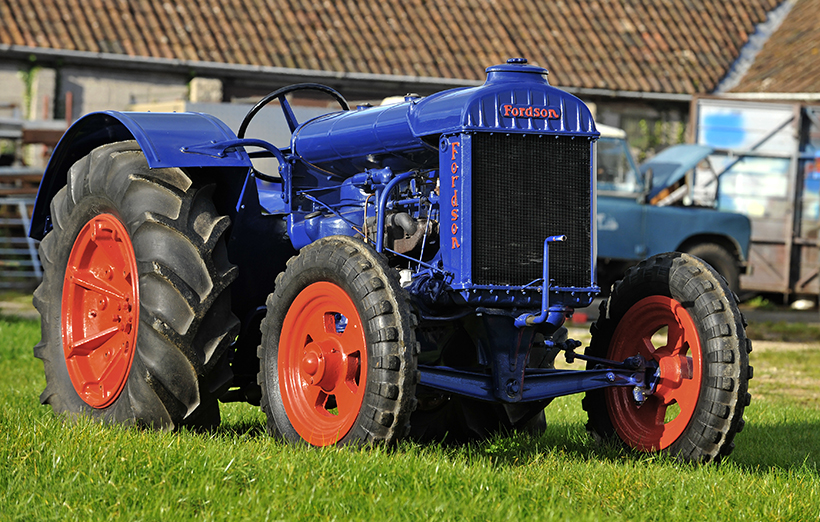
Buying a Fordson Model N is all about the detail. With so many parts being interchangeable with those from earlier and later models, it’s important to recognise if things like the front axle, exhaust, wheels, wings and steering wheel are correct for the year of manufacture.
There’s something rather amazing about being able to spend just a couple of thousand pounds to buy yourself a fully-functioning and still usable machine from the Second World War. Admittedly, I’m not talking about a Hawker Hurricane or a Churchill tank, but it’s arguable that, in its own way, the diminutive Fordson Model N tractor, played just as much of a part in the result of the war as either of those two more widely recognised mechanical heroes.
The Fordson Model N was introduced in 1929, as a replacement for the Model F. Production began in Cork, Ireland, but switched to Dagenham, Essex, just three years later, where it continued until the model’s demise, in 1945. Undoubtedly, the Model N had become very long in the tooth by the mid-1940s and its replacement, the E27N, was certainly a better and more capable tractor.
However, that’s not meant as any sort of slight against the Model N, which should be regarded as a landmark model. Its uncomplaining efforts during the hard war years were instrumental in helping to keep the UK fed and, for many farmers, the Model N was their first experience with mechanical power. It was the machine that weaned them away from working the land with horses and, for those reasons alone, it deserves a cherished place in the history of these islands.

This 1935 Model N belongs to Nick Bryne, and has been superbly restored and finished in Empire Blue and contrasting orange paint.
Hardy survivor
In reality, the Model N wasn’t all that different from the Model F it succeeded, and the design of that tractor stretched right back to 1917. Nevertheless, it was very successful; a machine that was built to work and last. The fact that so many of the nearly a quarter of a million that were built, went on working for 10, 20 and even 30 years beyond their sell-by date, is testament enough to the quality of the original design.
But, as a direct consequence of that often-extended working life, many Model Ns were kept running with a hotch-potch of replacement parts taken from other models. So, it’s common nowadays to find examples that have been fitted with both older and newer parts to keep them running. Back in the day, farmers did what was necessary to keep these machines operational, with understandably little regard for originality. Being a working, utility vehicle, the finer points of correct mechanical specification were very low on the list of priorities; the primary aim was always to keep the tractor useful, usually on the absolute minimum of budget.
Nowadays, anyone who fancies buying a Model N is faced with the choice between choosing an already restored machine, or one that’s still awaiting that process. In either case, whether or not the tractor will be ‘right’ in terms of specification, is the big question. Of course, much depends on your own objectives and expectations. Are you after an up-and-running machine simply to have some fun with at a few local shows and the odd ploughing match? Or is your aim to own a correctly specified Model N that accurately resembles the tractor that left the factory in Cork or Dagenham?
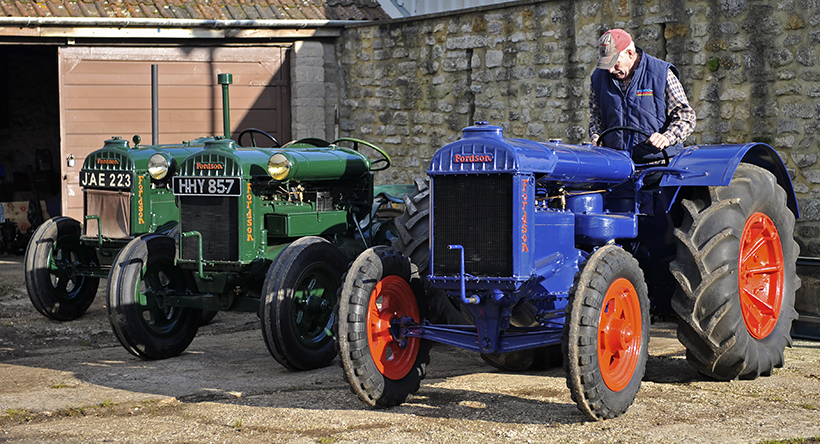
Nick Bryne’s trio of beautifully restored Model Ns; the green 1944 model in the background, the 1944 Industrial model in the centre, and the blue and orange 1935 model in the foreground.
For some experience-based insight into the dos and don’ts of buying, I took a trip to Somerset to consult Model N enthusiast, owner and restorer, Nick Bryne. He currently owns three Model Ns, and knows the tractor inside out, having restored all three of them to a very high standard. The first buying-related point he made was that buyers must expect existing owners to make all sorts of claims for the tractors they’re selling, regarding originality and restoration. In reality, though, the fact that these machines have all changed hands so many times in the past, makes it impossible in most cases to be completely sure about an individual machine’s history. So take things with a pinch of salt, and make decisions based on what you see in front of you.
Renovation prospects
The good news, however, is that the relative simplicity of the Model N’s design means that more or less every vehicle is recoverable, assuming you have the budget, time and patience needed for the project. Nevertheless, it’s important to approach ownership of one of these ageing machines with your eyes wide open. Given that you could be buying a machine that’s 90 years old, your expectations regarding on-going ownership, reliability levels and maintenance requirements must be realistic.
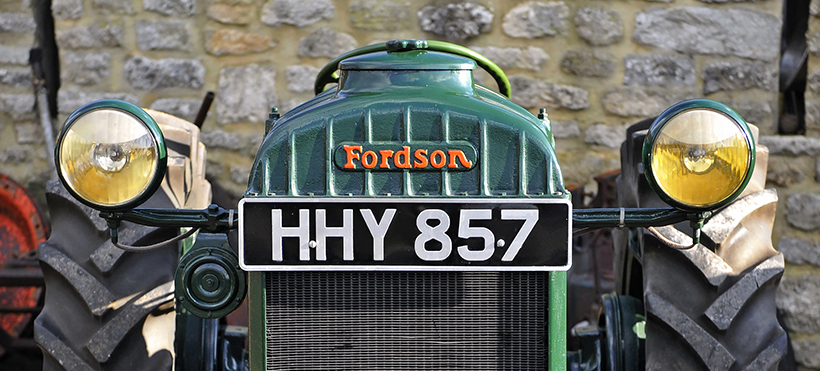
The industrial version was equipped for road running, with lights and a horn. The electrical system is correspondingly more complicated.
Nick advises that any buyer should do as much research as possible before spending any cash. “It’s important to be aware of what the machine you’re interested in should and shouldn’t be fitted with. There are plenty of good reference books, and lots of existing owners and experts within the Ford & Fordson Association, who will be happy to help with advice and information,” he told me.
“The reality now is that the chances of finding a good, original and unmolested Model N are next to nil. Almost all now will have some non-standard parts fitted – perhaps a glass-bowl fuel tap, a fuel tank from a later model or the wrong magneto – but how important are such details to you? If it’s a running machine that you can use and enjoy, and it’s selling for a price you can afford, then it could be a good choice.
“A traditionalist, on the other hand, will want all the detail to be correct, and will relish the challenge involved in tracking down the parts necessary to bring their machine back to ‘as new’ condition. Both ownership approaches have their pros and cons but, arguably, the most important factor is that as many tractors as possible are preserved and kept running.”
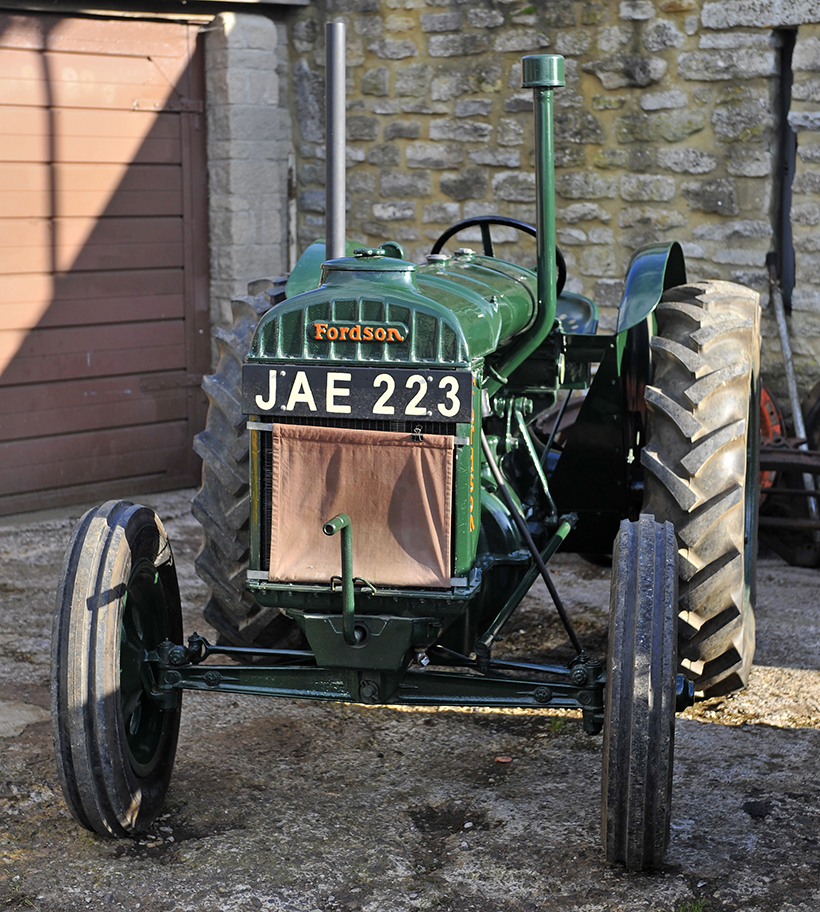
Narrow wings were a wartime economy measure, to save as much steel as possible for the war effort. The radiator blind was a common feature designed to speed engine warming.
Buying pointers
As well as all the usual pre-purchase checks (steering play, kingpin wear, tyre condition, presence of corrosion etc), there are several Model N-specific points which buyers should be aware of. For a start, with these tractors no longer having to work for a living, there isn’t the same pressure to keep them going through necessity. Couple this with the fact that values remain relatively low, and you have a situation where less sympathetic owners are reluctant to spend much money on an ailing Model N. Mechanical faults that can be relatively expensive to repair get ignored – as do many cosmetic issues – because there’s a growing perception now that these models simply aren’t worth the investment needed to bring them back up to scratch.
“Model Ns being sold today will often be suffering with lots of niggling (and sometimes more serious) issues, which the previous owner never felt it was worthwhile dealing with,” Nick explained. “This is a great shame as, ultimately, such problems only ever get worse, and have an inevitable, knock-on and detrimental effect on the overall condition of the machine.
“A common problem that afflicts the Model N relates to the electrical system and, in particular, the magneto. Problems with this cause engine cut-outs and starting difficulties when hot. Originally, the tractor was fitted with a Bosch unit which performed very well but was unobtainable when war broke out. So Fordson switched to the Lucas GJ4 unit during the war years, but this was found by many to be a good deal less reliable, even though it performed well in Morris cars of the period. As a consequence of this, and the extra cost involved in switching back to a Bosch unit, lots of tractors were subsequently fitted with the Lucas RF4 magneto, when it became available.

This is a Lucas GJ4 magneto that was fitted to the Model N following the outbreak of WW2. In practice, it wasn’t a great performer, perhaps due to its exposed position.
“It is possible to test the magneto, by driving it using an electric drill (or on a lathe), then monitoring the output as the body of the unit is heated using a hot air gun (to simulate the heat effect associated with real-life operation). The problem is that the copper coils inside the magneto become cracked with age and, when exposed to heat, the wires expand which opens the gap and breaks the circuit. Allowing the unit to cool again closes the gap, the voltage starts flowing again and the engine can be started.
“Talking of the engine, the age of these tractors means that internal, mechanical wear can be a serious issue (piston rings, bores, bearings etc). If you decide to buy a tractor with a badly worn engine – that can be heard knocking – then be prepared for the fact that the cost of getting a specialist to put that right is likely to exceed the value of the tractor.”
Bearing wear
“The bearings inside the transmission are another relatively common wear point on the Model N. Replacements are available, but fitting is a big and potentially expensive job if you’re paying somebody else to do it. Front axles are something to be wary of, as well. There were two types used by Fordson on the Model N – a straight one and a bowed version. There have been instances where the bowed version has been wrongly fitted to a Model N that was designed for a straight one, resulting in a ride height that’s far too low.
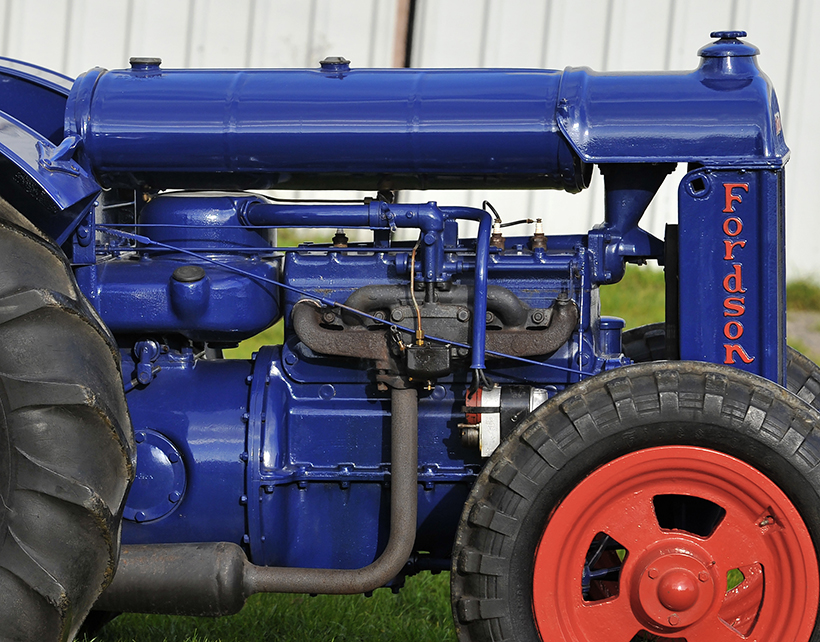
This 1935 Model N is fitted with the early, low-slung exhaust. A variety of exhaust and manifold options was used during the production run, all of which are interchangeable.
“The brake and clutch are operated by one pedal on this tractor – the first portion of the pedal travel operates the clutch while movement beyond that operates the brakes. It’s a transmission brake fitted to this model which, despite the age of the design, can still be reasonably effective assuming wear levels aren’t excessive. However, worn brakes are commonly found simply because of the cost involved in putting them right.
“Replacement parts are available, but fitting them can be an issue for less experienced owners. The tractor has to be split, so that the front of the transmission can be pulled off to gain the necessary access. But the job is doable on a DIY basis and, once again, there’s always help at the end of the phone from the many, mechanically-minded FFA members.
“As I’ve already mentioned, the Model N’s electrical system is very rudimentary. All it consists of is the magneto and the four leads running to the spark plugs. The one exception to this simplicity is the industrial version, which was equipped for road running, so included lights and a horn that complicate the electrical system to a degree.
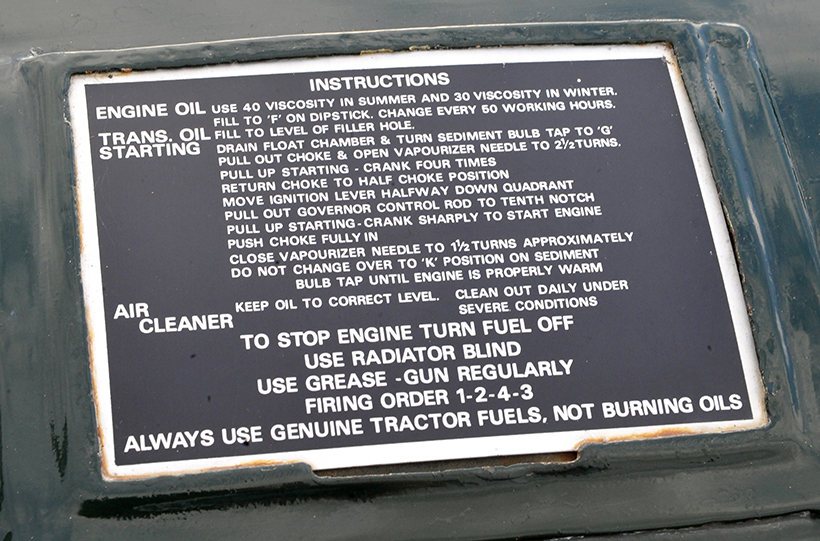
Starting and running instructions were provided on the fuel tank of wartime models, to remind and help users keep the machines running as reliably as possible.
“At a more general level, a common mistake that buyers when looking at a prospective purchase is to fail to check that the back wheels are a matching pair. Back in the day, owners of tractors like the Model N would happily mix and match parts when problems arose, and do so as cheaply as possible. So, if a wheel or tyre got damaged, a farmer would often opt to take a replacement off an older tractor, regardless of whether it was a matching wheel or not. First-time buyers, carried away with the excitement of viewing the tractor, can fail to notice such details, so always take your time when assessing a tractor.”
Other details
Nick continued: “Steering wheel designs ranged over the years, with subtle changes being made during the model’s production life. All Model Ns should be fitted with a four-spoke, not a three-spoke version from a Major. The earliest, Cork-made models featured much heavier spokes and additional drillings on the back boss. The steering wheels on ‘water-washer’ models had a powder-coated rim while, on later models, Fordson switched to a tubular steel rim, with indentations pressed into it and a coating for added grip. After this, a Bakerlite-like coating was added which, of course, hardens, cracks and falls off with age.
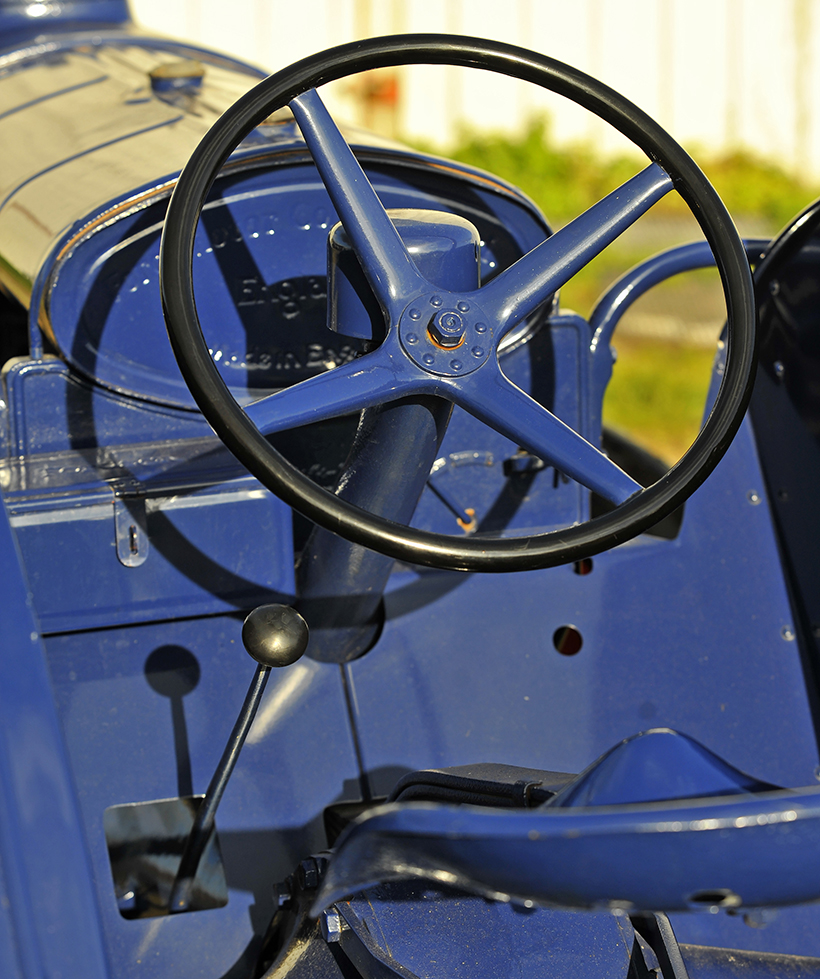
The simplest of controls on this 1935 Model N. The four-spoke steering wheel with coated rim is correct for the period. Wartime models got a radiator-mounted temperature gauge.
“It’s also sensible to take a few minutes to check for wear at the business end of the starting handle. While the tip of the handle itself isn’t usually a problem (a worn pin can be replaced), the dog tooth that it engages with on the front pulley needs to be in good order. This inevitably wears with age, until it becomes so rounded-off that it becomes impossible to turn the engine. New pulleys aren’t available, so the options are either to source a good, secondhand one, or to carefully re-shape the original with a grinder to create a new ‘tooth’, although there’s only really enough metal to do this once.”
Overall, then, given the relatively minor nature of the problems that characteristically afflict the Model N, it’s actually quite hard to make a serious mistake when buying one. The fact that you don’t have to invest thousands to secure an entry-level runner means that buyers are comfortingly insulated from financial disaster. However, it’s important to appreciate that there can be significant repair/restoration costs involved if you’re set on producing a pristine and age-appropriate example. What’s more, with values as they are, Model N renovation is very unlikely to prove profitable; essentially, it needs to be a labour of love.
Given the historical importance of this tractor, its mechanical simplicity and the fact that it remains an utterly usable proposition up to 90 years after manufacture, it’s difficult to understand why values aren’t much higher. Nick has some interesting views on the subject. “There’s a growing demand for easy-to-live-with options,” he told me. “Many new owners want to turn a key to get their tractor going, not swing a handle. Starting the Model N’s engine involves a specific, multi-stage procedure, which some find off-putting.”
Getting started
“The engine has to be primed and then started on petrol, then switched over to TVO once it’s properly warmed. What’s more, every engine tends to have its own particular foibles, which owners can only appreciate with experience. So, the method for getting one started is likely to vary slightly from engine to engine; it’s a case of getting to know your motor, how it runs and what needs to be tweaked when it doesn’t.

The type of tow hitch fitted is a point worth noting. As standard, Fordson fitted a straightforward plate on the Model N, but the Russell adaptive drawbar (as seen here) is a far more desirable and versatile option.
“There also seems to be less tolerance among tractor buyers these days towards unreliability. New owners want their machines to be trouble-free and straightforward to take to shows, and ever fewer want to be messing around with TVO; so newer, diesel-powered machines from the ‘classic’ period are more in demand than older tractors from the vintage era.
“In my view, Model N owners must be prepared to put the effort in. It’s not the sort of tractor that responds well to being shut away in a shed and ignored for months at a time. These old Ford engines require nurturing and mechanical sympathy, and can never be taken for granted. In practice, the reality is that very few Model N owners are lucky enough to own a tractor that will perform with complete reliability on every occasion. Getting even close to that situation requires a level of attention to detail that, regrettably, fewer and fewer owners seem able to deliver, nowadays.”
Having said all that, the charm offered by a Model N – whatever its condition – is undeniable. It’s a neatly styled, attractive little tractor that played an important part in history, and lived to tell the tale. So, if you fancy a slice of genuine agricultural aristocracy, and hanker after running a tractor of which you can be genuinely proud, then you really should be giving a Model N some serious consideration.
WHAT TO PAY
At the bottom end of the market, it’s still possible to find entry-level Model Ns selling for £300-£400. But these tractors are unlikely to be runners, and will probably have bits missing, too.
To buy a running Model N which is all there, but in need of work, you should expect to pay at least £1,200. However, with Model Ns at this price, you must expect it to be fitted with various incorrect parts, and be prepared to spend some money if you want to bring it back to the correct specification for its year of manufacture.
At the top of the market these days, a really good Model N will typically fetch about £4,000.
Owner’s view: Nick Bryne
I bought my first Model N – a 1944 industrial version – in 1984, although I’d owned an E27N before this. I’ve always been a Ford man (cars and tractors) but first got involved with the tractor side of things because a friend had an E27N half-track. My interest has developed steadily since then, and I still have the original E27N.
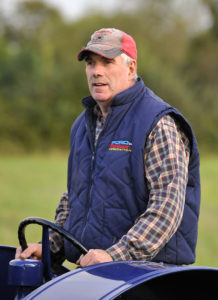
After I’d restored that first Model N industrial, my appetite was well and truly whetted, and I bought two more Ns – 1944 and 1935 models – both of which are now fully restored to as near original condition as I can get them. My aim has never been to restore tractors for re-sale, and the only time I sell things is if I’ve bought a machine as a parts donor. After I’ve removed what I need, I’ll then break what left and sell the parts, or move the vehicle on as one if there’s a buyer for it.
Fordsons have always been the tractor for me, and I really enjoy working on vintage tractors. I have so much experience on these models now that I feel completely at home dealing with all aspects of their renovation. I work on newer tractors for a living, so I appreciate the contrast and genuinely prefer working on my older machines.
I’ve developed a real attachment to the Model N over the past 35 years, and can’t ever see myself not having one or two in the shed. If I was forced to choose a favourite, I’d go for my green, 1944 narrow-wing model. That tractor was such a mess when I bought it about 12 years ago, and I and my two sons worked hard to bring it back to life.
MODEL N MILESTONES
• In 1929 Ford’s tractor production moved from Dearborn, Michigan to Cork, Ireland, and the Model N was introduced, finished in grey paint.
• Model N boasted a 3hp power increase compared to the outgoing Model F. Cooling system (water pump added) and electrics (high-tension magneto) also upgraded. Larger water-washer air cleaner specified, with domed top.
• Heavier front axle and wheels included to help minimise the risk of front-end lifting. Wings
• Production of Model N moved to Ford’s Dagenham, Essex factory in 1932. In 1933, the colour scheme changed to dark blue with red wheels.
• Other improvements made included shortening the wings (re-locating the toolbox to the dash area or on the nearside of the engine). Shorter wings improved turning ability when towing an implement. Clutch pedal moved and seat positioned further back to aid implement operation.
• A PTO was added in 1934 and the option of inflatable tyres arrived a year later, as an alternative to steel wheels with spade lugs.
• Factory switched to ‘Harvest gold’ (orange) paint for the Model N in 1937. A higher-compression cylinder head was also fitted, to produce more power and run on the more efficient tractor vapourising oil (TVO). New, vertical air intake and exhaust stacks added on either side of the engine, and the water-washer air cleaner system was replaced by a new, oil bath-based system (eliminating freezing risk).
• Fordson changed from conspicuous, Harvest Gold paint to a less obvious dark green, once war broke out in 1939. Wartime shortages also resulted in narrower wings but a radiator-top temperature gauge was added.
• Model N production ended in the summer of 1945, with a total of 235,000 having been built.
| MODEL N TECH SPECS | |
| Years produced | 1929-1932 in Cork, Ireland |
| 1933-1945 in Dagenham, Essex | |
| Engine | 267cu in. (4,379cc) |
| Power output | 21hp |
| Paint colours | 1929-1931: Grey |
| 1932: Sir John Burr blue (transitional tractors) | |
| 1932-1937: Empire Blue/Orange (Essex cart colours) | |
| 1937-1940: Harvest Gold | |
| 1940-on: Green | |
| Length | 102in |
| Width | 63in |
| Wheelbase | 63in |
| Height | 55in (exhaust type dependant) |
| Weight | 3,600lbs (1,636kg) |
| Number made | Cork – 31,453 |
| Dagenham – 204,493 | |
| Total produced | 235,946 |
For a money-saving subscription to Ford & Fordson Tractors magazine, simply click here





